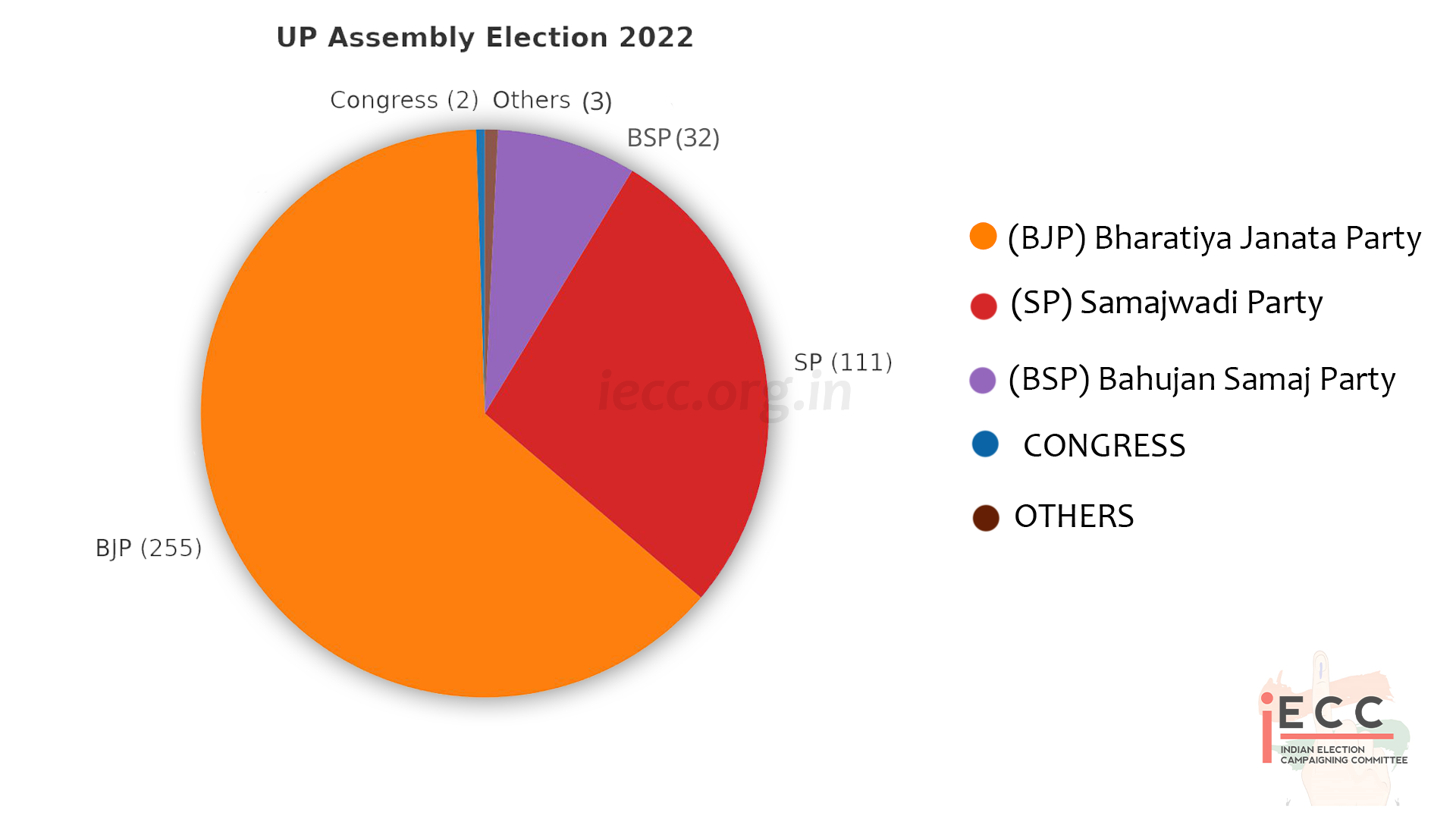Uttar Pradesh Assembly Election
1952 Uttar Pradesh Legislative Assembly Election Results
| 1952 Uttar Pradesh Assembly Election Results | |||
|---|---|---|---|
| Sr. No. | Short Name | Full Name | Seats |
| 1 | INC | Indian National Congress | 388 |
| 2 | Socialist Party | Socialist Party | 20 |
| Total | 408 | ||
The Congress Party won 388 out of 430 seats, an overwhelming victory.
This was one of the biggest mandates in UP’s history, showing the dominance of Congress in early years.
The Socialist Party (20 seats) and Ram Rajya Parishad (9 seats) were minor players.
Govind Ballabh Pant (INC) was sworn in as the first elected Chief Minister of Uttar Pradesh (he had already been CM in the interim government before 1952).
The result set the tone for Congress dominance in UP for the next two decades.
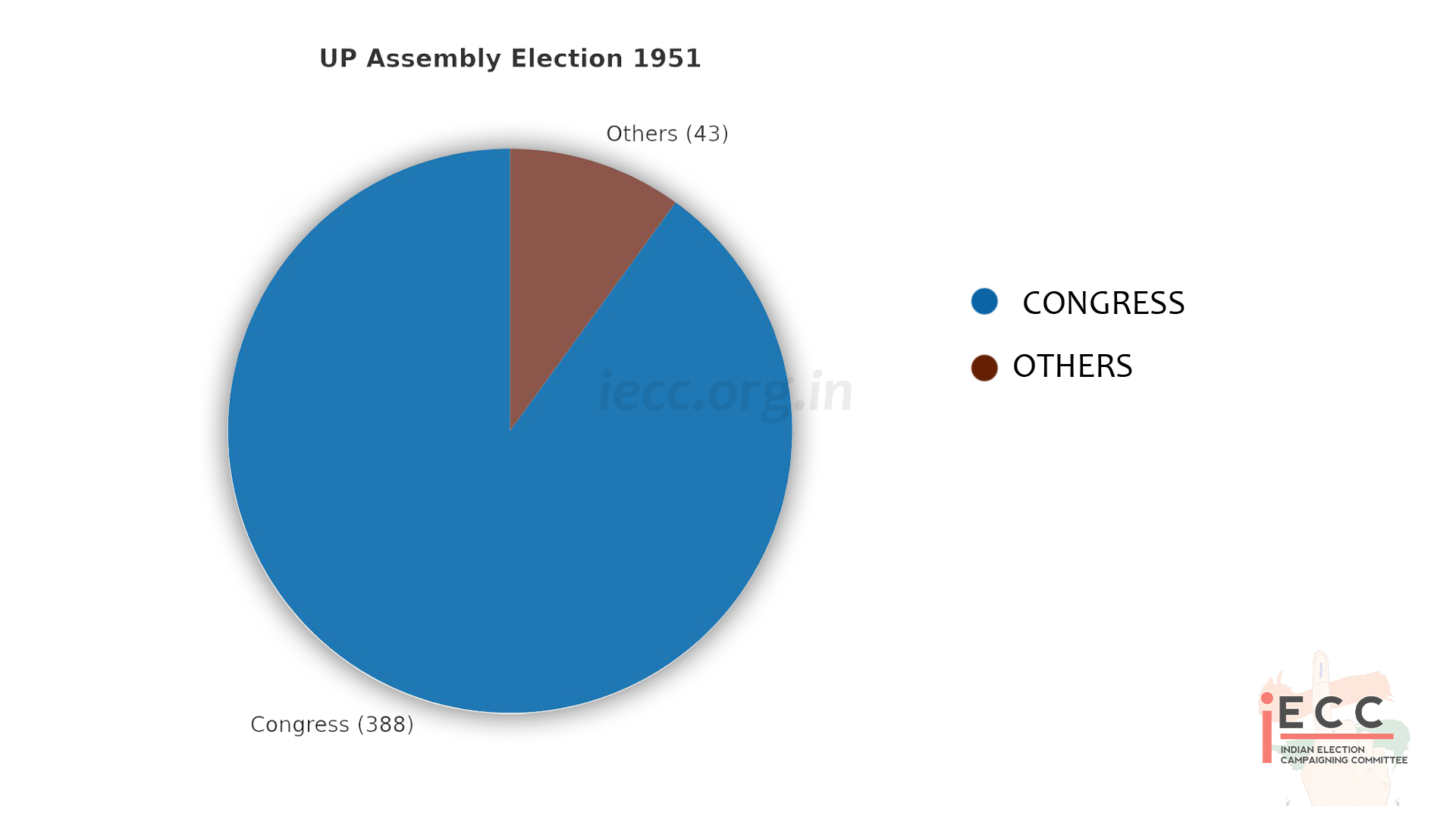
1957 Uttar Pradesh Legislative Assembly Election Results
| 1957 Uttar Pradesh Legislative Assembly Election Results | |||
|---|---|---|---|
| Sr. No. | Short Name | Full Name | Seats |
| 1 | INC | Indian National Congress | 286 |
| Total | 286 | ||
The Congress won 286 seats, fewer than in 1952 but still a clear majority.
The Praja Socialist Party (PSP) emerged as the main opposition with 44 seats, replacing the Socialists of 1952.
The Bharatiya Jana Sangh (BJS) made early inroads with 17 seats, beginning its long journey in UP politics.
The CPI and independents had smaller roles.
Sampurnanand (INC) became the Chief Minister of UP.
This election marked the beginning of Congress facing stronger opposition, though it was still dominant.
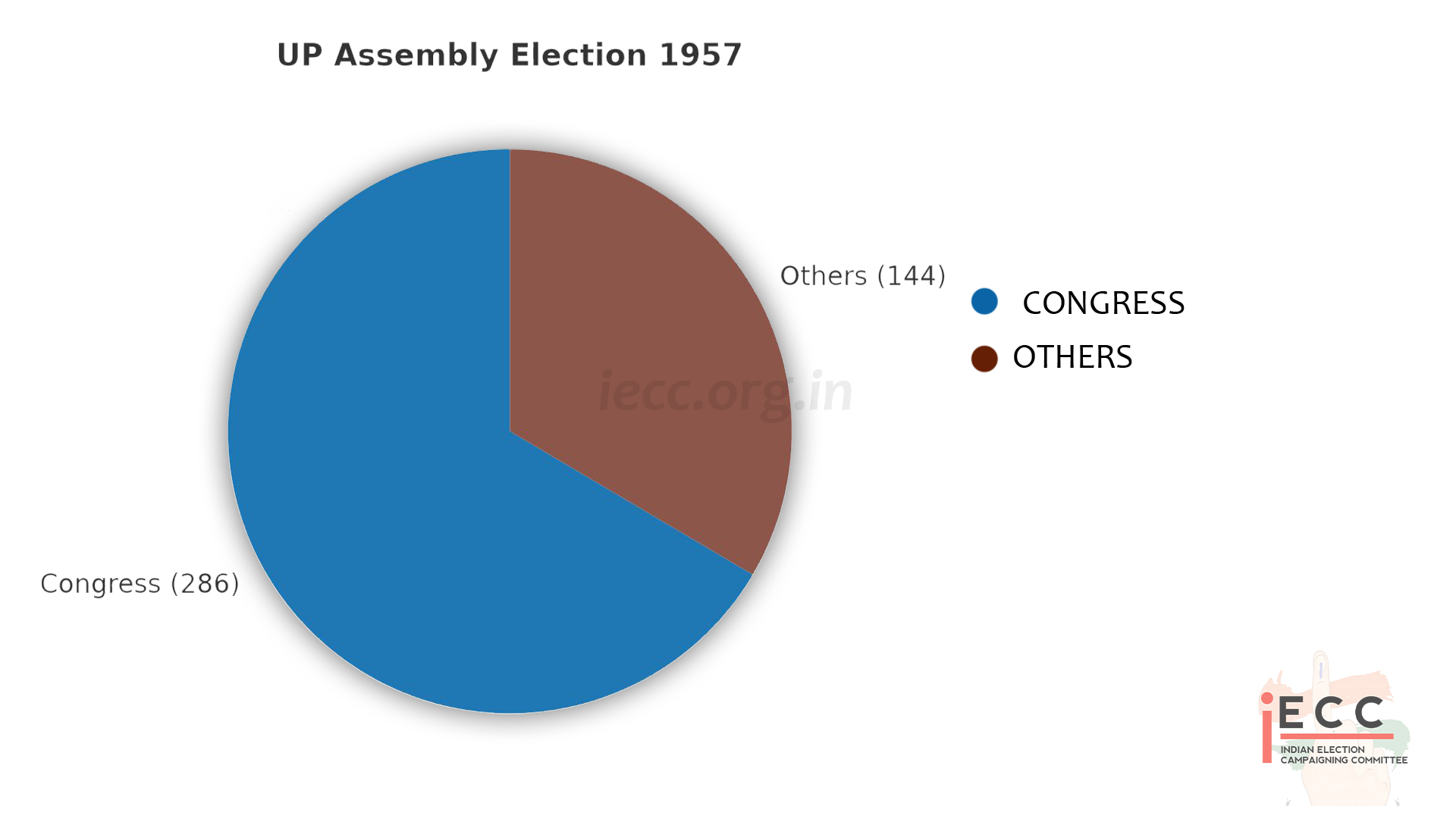
1962 Uttar Pradesh Legislative Assembly Election Results (Projected)
| 1962 Uttar Pradesh Legislative Assembly Election Results (Projected) | |||
|---|---|---|---|
| Sr. No. | Short Name | Full Name | Seats |
| 1 | INC | Indian National Congress | 249 |
| 2 | BJS | Bharatiya Janata Sangh | 49 |
| 3 | PSP | Praja Socialist Party | 38 |
| 4 | CPI | Communist Party of India | 15 |
| 5 | RPI | Republican Party of India | 6 |
| 6 | Others / Independents | Others / Independents | 73 |
| Total | 430 | ||
The Congress Party won 249 seats, enough for a clear majority but a decline compared to 1957 (286 seats).
The Bharatiya Jana Sangh (BJS) made significant gains, winning 49 seats, and became the largest opposition party.
The PSP declined to 38 seats, losing ground to BJS.
The CPI (15 seats) and RPI (6 seats) had limited but notable influence.
Independents and smaller parties collectively secured 73 seats, showing fragmentation.
Chandra Bhanu Gupta (Congress) was chosen as the Chief Minister.

1967 Uttar Pradesh Legislative Assembly Election Results (Projected)
| 1967 Uttar Pradesh Legislative Assembly Election Results (Projected) | |||
|---|---|---|---|
| Sr. No. | Short Name | Full Name | Seats |
| 1 | INC | Indian National Congress | 199 |
| 2 | BJS | Bharatiya Janata Sangh | 98 |
| 3 | SSP | Samyukta Socialist Party | 44 |
| 4 | PSP | Praja Socialist Party | 11 |
| 5 | CPI | Communist Party of India | 12 |
| 6 | Swatantra Party | Swatantra Party | 12 |
| 7 | RPI | Republican Party of India | 9 |
| 8 | Others / Independents | Others / Independents | 40 |
| Total | 425 | ||
The Congress won 199 seats, its first failure to reach a majority in UP.
The Bharatiya Jana Sangh (98 seats) made major inroads, becoming a real challenger.
Opposition parties formed the Samyukta Vidhayak Dal (SVD) coalition, which included BJS, SSP, PSP, Swatantra Party, CPI, and others.
This coalition was a broad anti-Congress alliance, bringing together both left-wing socialists and right-wing parties.
Chaudhary Charan Singh (from Bharatiya Kranti Dal, later part of the opposition front) became Chief Minister, marking the first non-Congress government in UP.
However, due to instability and defections, UP politics entered an era of frequent changes in government.
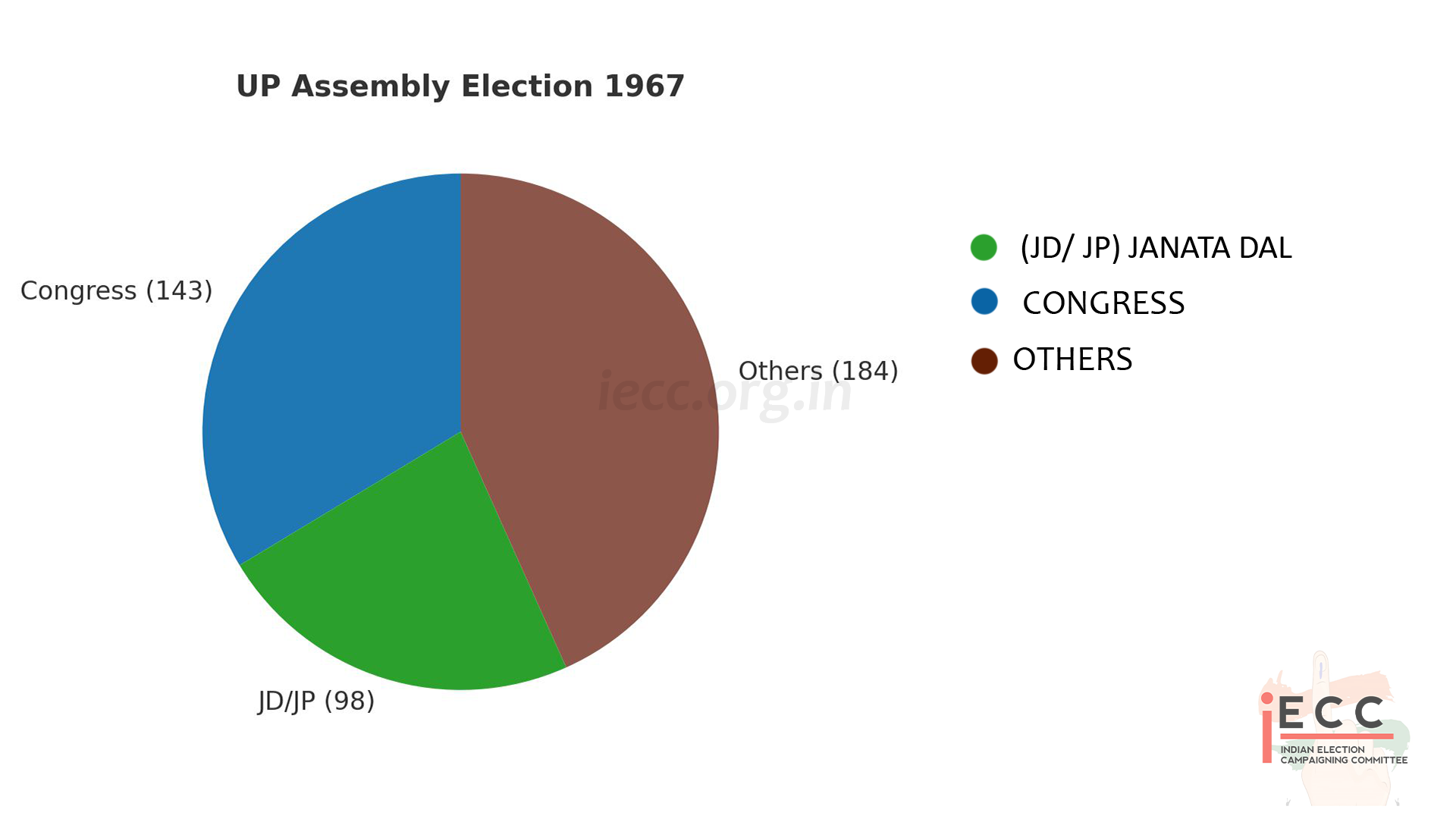
1969 Uttar Pradesh Legislative Assembly Election Results (Projected)
| 1969 Uttar Pradesh Legislative Assembly Election Results (Projected) | |||
|---|---|---|---|
| Sr. No. | Short Name | Full Name | Seats |
| 1 | INC | Indian National Congress | 211 |
| 2 | Congress (O) | Congress (O) | 28 |
| 3 | BKD | Bharatiya Kranti Dal | 98 |
| 4 | BJS | Bharatiya Janata Sangh | 49 |
| 5 | SSP | Samyukta Socialist Party | 33 |
| 6 | CPI | Communist Party of India | 12 |
| 7 | Others / Independents | Others / Independents | 0 |
| Total | 431 | ||
The Congress (R) under Indira Gandhi won 211 seats, just 2 short of majority, and emerged as the largest party.
The Bharatiya Kranti Dal (BKD) of Charan Singh remained strong with 98 seats, consolidating Jat and farmer votes.
The BJS declined slightly to 49 seats.
The Congress split into (R) and (O) weakened its overall dominance but Indira Gandhi’s faction was clearly stronger.
After the election, Chandra Bhanu Gupta (Congress-R) formed the government.
But instability and defections continued, showing UP’s entry into a volatile political phase.

1974 Uttar Pradesh Legislative Assembly Election Results (Projected)
| 1974 Uttar Pradesh Legislative Assembly Election Results (Projected) | |||
|---|---|---|---|
| Sr. No. | Short Name | Full Name | Seats |
| 1 | INC | Indian National Congress | 215 |
| 2 | BKD | Bharatiya Kranti Dal | 106 |
| 3 | BJS | Bharatiya Jana Sangh | 61 |
| 4 | CPI | Communist Party of India | 16 |
| 5 | SSP | Samyukta Socialist Party | 12 |
| 6 | Others / Independents | Others / Independents | 15 |
| Total | 425 | ||
The Congress (R) won 215 seats, just 2 above the majority mark, retaining power.
The BKD (106 seats) under Chaudhary Charan Singh was the largest opposition force, reflecting rural and farmer support.
The BJS (61 seats) strengthened its presence, preparing ground for later dominance.
Socialists and Communists remained marginal players.
Despite Congress’s narrow majority, political unrest, inflation, and student movements created instability, leading into the Emergency of 1975–77.
After the election, Hemwati Nandan Bahuguna (Congress-R) became Chief Minister.
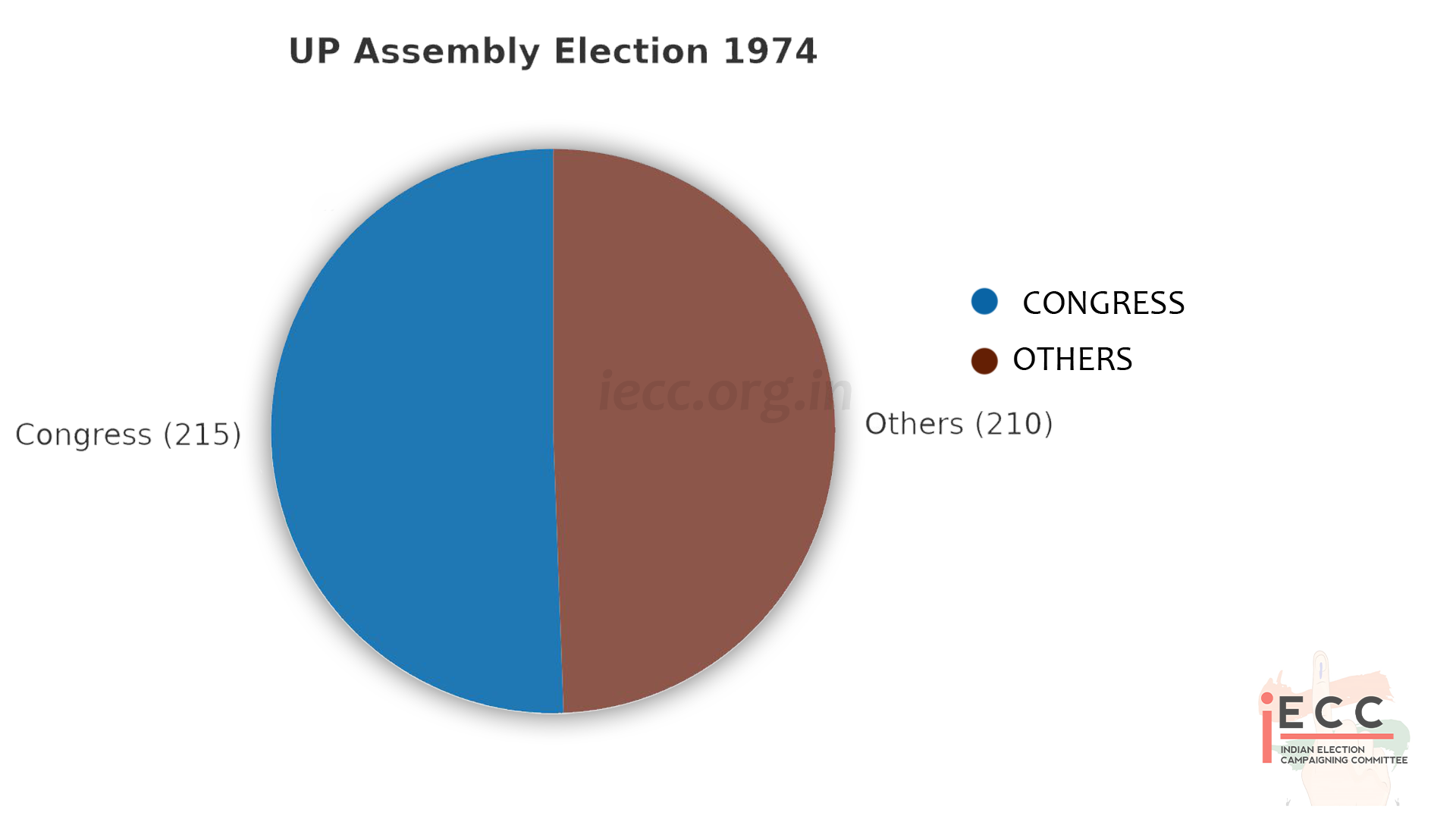
1977 Uttar Pradesh Legislative Assembly Election Results
| 1977 Uttar Pradesh Legislative Assembly Election Results | |||
|---|---|---|---|
| Sr. No. | Short Name | Full Name | Seats |
| 1 | Janata Party | Janata Party | 352 |
| 2 | INC | Indian National Congress | 47 |
| 3 | CPI | Communist Party of India | 9 |
| 4 | Independents & Others | Independents & Others | 17 |
| Total | 425 | ||
The 1977 election was the first held after the Emergency (1975–77) declared by Prime Minister Indira Gandhi.
The Janata Party, a coalition formed by merging opposition groups (Bharatiya Lok Dal, Bharatiya Jana Sangh, Congress (O), Socialist Party, etc.), swept the state with 352 seats — one of the biggest landslides in UP’s history.
The Indian National Congress (INC) collapsed to just 47 seats, a historic low.
The Communist Party of India (CPI) managed only 9 seats, while independents and small groups took the rest.
Chief Minister after election: Ram Naresh Yadav (Janata Party).
This election marked the end of uninterrupted Congress dominance in Uttar Pradesh (1952–1974) and the beginning of coalition and opposition-led governments in the state.
👉 Would you like me to also prepare the 1980 election seat list in the same detailed style (party-wise + description)?
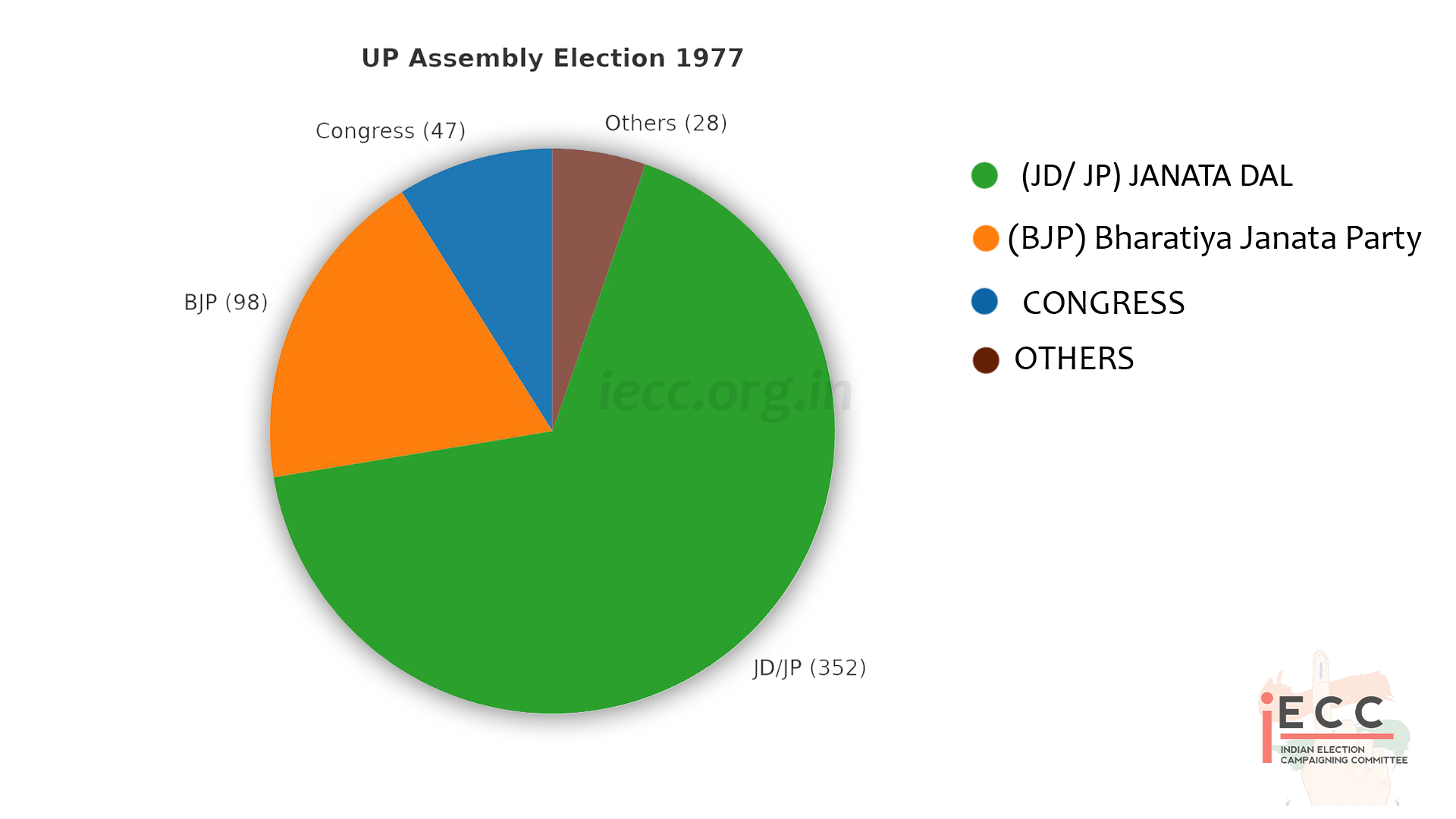
1980 Uttar Pradesh Legislative Assembly Election Results
| 1980 Uttar Pradesh Legislative Assembly Election Results | |||
|---|---|---|---|
| Sr. No. | Short Name | Full Name | Seats |
| 1 | INC | Indian National Congress | 309 |
| 2 | Janata Party (Secular) | Janata Party (Secular) | 59 |
| 3 | (BJP – first time) | Bharatiya Janata Party | 11 |
| 4 | CPI | Communist Party of India | 7 |
| 5 | Independents & Others | Independents & Others | 39 |
| Total | 425 | ||
After the collapse of the Janata Party government at the Centre and in UP, fresh elections were held in 1980.
The Indian National Congress (INC) staged a strong comeback, winning 309 seats — a comfortable majority.
This election also marked the first appearance of the Bharatiya Janata Party (BJP) in Uttar Pradesh politics (formed in 1980 from Bharatiya Jana Sangh), though it won only 11 seats.
The Janata Party (Secular), a breakaway faction, secured 59 seats.
Chief Minister after election: Vishwanath Pratap Singh (INC) took office, later succeeded by Sripati Mishra.
The result showed that despite the 1977 anti-Congress wave, the party could still bounce back strongly in UP.
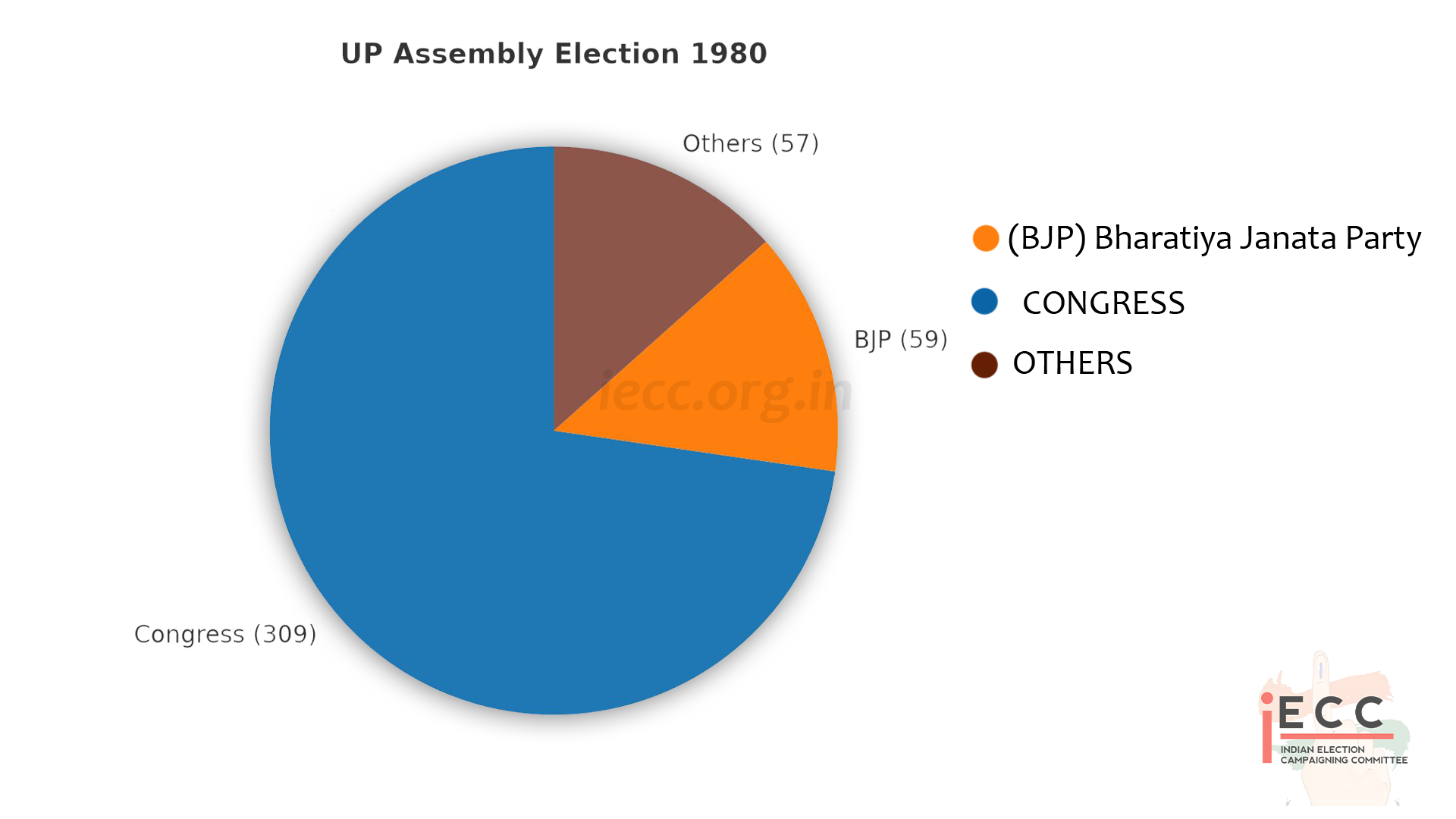
1985 Uttar Pradesh Legislative Assembly Election Results
| 1985 Uttar Pradesh Legislative Assembly Election Results | |||
|---|---|---|---|
| Sr. No. | Short Name | Full Name | Seats |
| 1 | INC | Indian National Congress | 269 |
| 2 | Lok Dal | Lok Dal | 84 |
| 3 | BJP | Bharatiya Janata Party | 16 |
| 4 | CPI | Communist Party of India | 6 |
| 5 | CPI | Communist Party of India (Marxist) (CPI-M | 4 |
| 6 | Independents & Others | Independents & Others | 46 |
| Total | 425 | ||
The 1985 election took place after Indira Gandhi’s assassination in 1984, which created a sympathy wave for the Congress.
The Indian National Congress (INC), led in UP by Narayan Dutt Tiwari, won 269 seats, giving it a clear majority (though less than the 309 seats it had won in 1980).
The Lok Dal, led by Charan Singh, emerged as the main opposition with 84 seats, consolidating support among farmers and rural voters.
The Bharatiya Janata Party (BJP) improved slightly, winning 16 seats, beginning its slow but steady growth in UP.
Left parties (CPI & CPI-M) together secured 10 seats, while independents and smaller groups won 46 seats.
Chief Minister after election: N.D. Tiwari (INC) became CM, and this was the last time Congress won a majority on its own in UP.
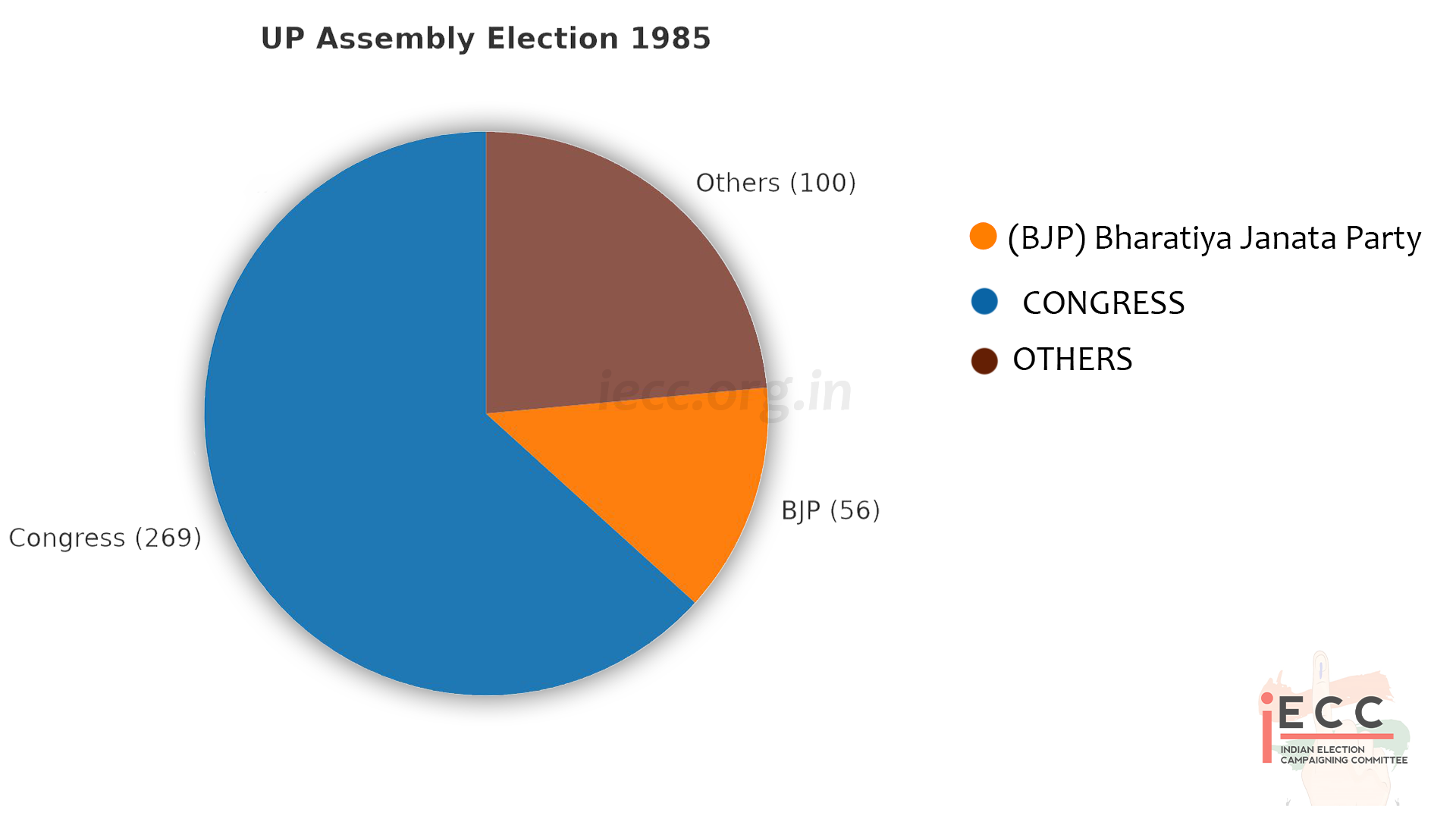
1989 Uttar Pradesh Legislative Assembly Election Results
| 1989 Uttar Pradesh Legislative Assembly Election Results | |||
|---|---|---|---|
| Sr. No. | Short Name | Full Name | Seats |
| 1 | Janata Dal | Janata Dal | 208 |
| 2 | INC | Indian National Congress | 94 |
| 3 | BJP | Bharatiya Janata Party | 57 |
| 4 | Lok Dal | Lok Dal | 11 |
| 5 | CPI | Communist Party of India | 7 |
| 6 | CPI | Communist Party of India | 5 |
| 7 | Independents & Others | Independents & Others | 43 |
| Total | 425 | ||
The 1989 election was held in the backdrop of anti-Congress sentiment across India, mainly due to corruption allegations (Bofors scandal) and rising caste & regional movements in UP.
The Janata Dal (formed by V.P. Singh after leaving Congress) won 208 seats, emerging as the largest party but short of majority.
The Congress (INC) suffered a heavy defeat, falling to 94 seats, ending its long dominance in Uttar Pradesh.
The BJP rose significantly, winning 57 seats, signaling its growing strength in the state, especially around the Ram Janmabhoomi movement that was gaining momentum.
Left parties (CPI & CPI-M) together managed 12 seats, while independents and small parties won 43.
Chief Minister after election: Mulayam Singh Yadav (Janata Dal) took office with outside support, marking the rise of OBC politics in UP.
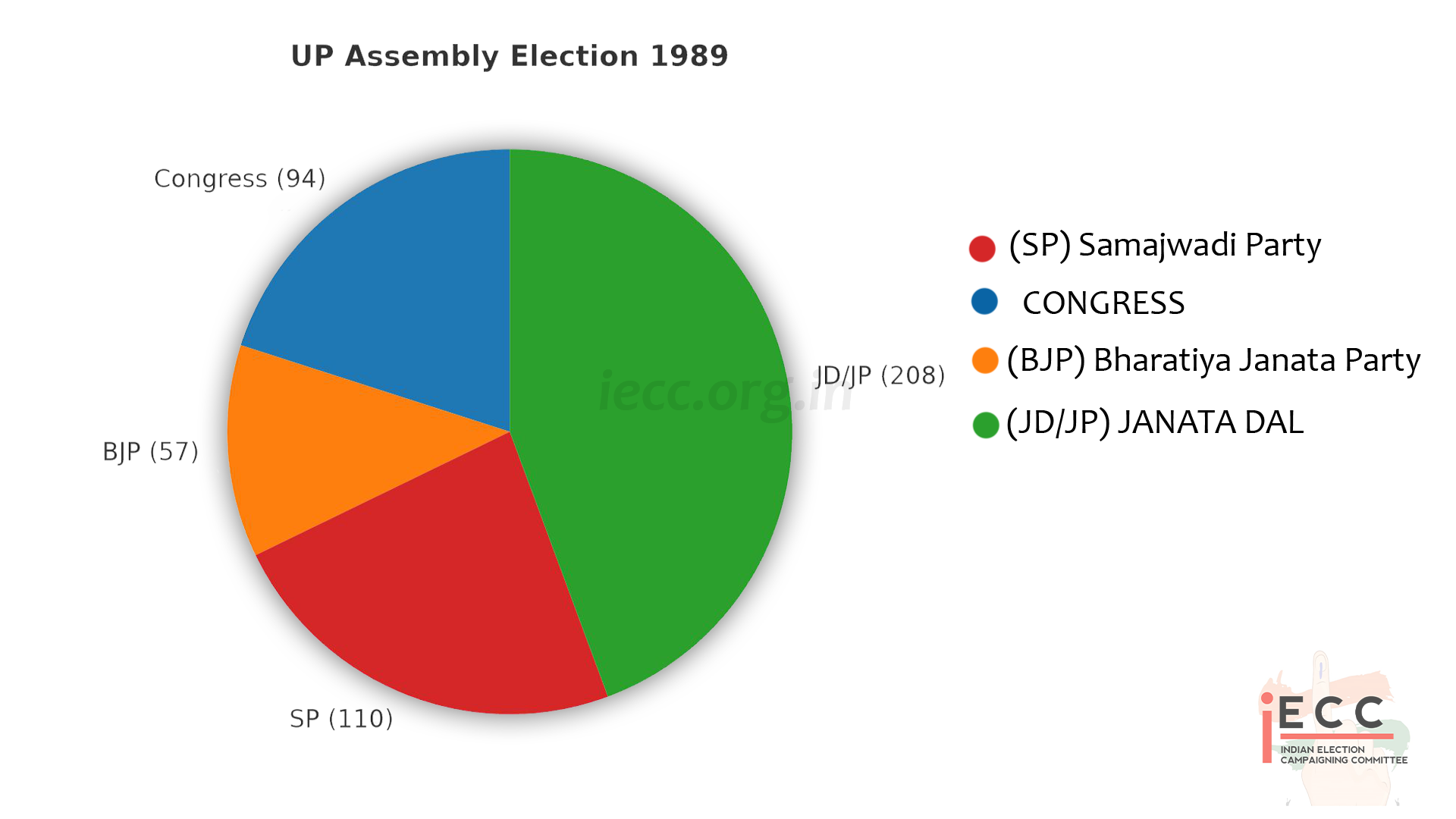
1991 Uttar Pradesh Legislative Assembly Election Results
| 1991 Uttar Pradesh Legislative Assembly Election Results | |||
|---|---|---|---|
| Sr. No. | Short Name | Full Name | Seats |
| 1 | BJP | Bharatiya Janata Party | 221 |
| 2 | INC | Indian National Congress | 46 |
| 3 | Janata Dal | Janata Dal | 92 |
| 4 | (BSP) – 1st big entry | Bahujan Samaj Party | 12 |
| 5 | CPI | Communist Party of India | 5 |
| 6 | (Marxist) (CPI-M) | Communist Party of India | 2 |
| 7 | Independents & Others | Independents & Others | 47 |
| Total | 425 | ||
The 1991 election marked the rise of the BJP as the dominant force in Uttar Pradesh politics.
Riding on the Ram Janmabhoomi movement and Hindu nationalist wave, the BJP won 221 seats, securing a clear majority.
The Congress (INC) declined sharply to just 46 seats, one of its worst-ever performances in UP.
The Janata Dal (Mulayam Singh Yadav’s base) managed 92 seats, remaining influential among OBC and rural voters.
The Bahujan Samaj Party (BSP), contesting strongly for the first time, won 12 seats, representing Dalit assertion in state politics.
Chief Minister after election: Kalyan Singh (BJP) became CM, beginning BJP’s first government in Uttar Pradesh.
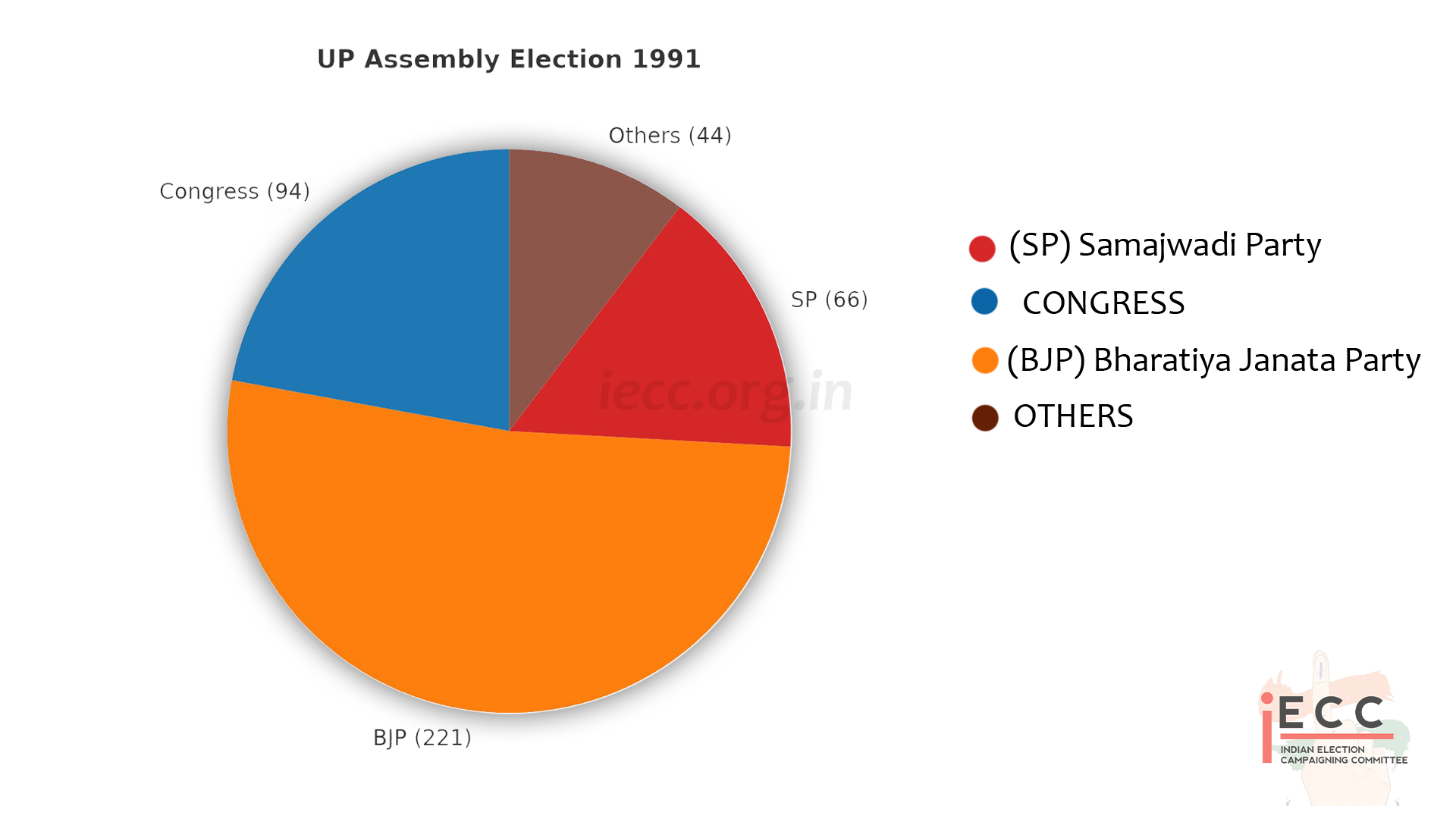
1993 Uttar Pradesh Legislative Assembly Election Results
| 1993 Uttar Pradesh Legislative Assembly Election Results | |||
|---|---|---|---|
| Sr. No. | Short Name | Full Name | Seats |
| 1 | BJP | Bharatiya Janata Party | 177 |
| 2 | SP | Samajwadi Party | 109 |
| 3 | BSP | Bahujan Samaj Party | 67 |
| 4 | INC | Indian National Congress | 28 |
| 5 | Janata Dal | Janata Dal | 27 |
| 6 | CPI | Communist Party of India | 10 |
| 7 | (Marxist) (CPI-M) | Communist Party of India | 2 |
| 8 | Independents & Others | Independents & Others | 5 |
| Total | 425 | ||
The 1993 election came in the aftermath of the Babri Masjid demolition (1992), which deeply polarized Uttar Pradesh politics.
The BJP won the most seats (177), but fell short of majority.
A historic alliance between Samajwadi Party (SP) and Bahujan Samaj Party (BSP) stopped the BJP from forming government.
SP (109) and BSP (67) together formed the government with outside support from Congress and Left.
Chief Minister after election: Mulayam Singh Yadav (SP) became CM with Mayawati (BSP) as an ally.
This was the beginning of caste-based coalition politics in UP, with SP representing OBCs and BSP representing Dalits.
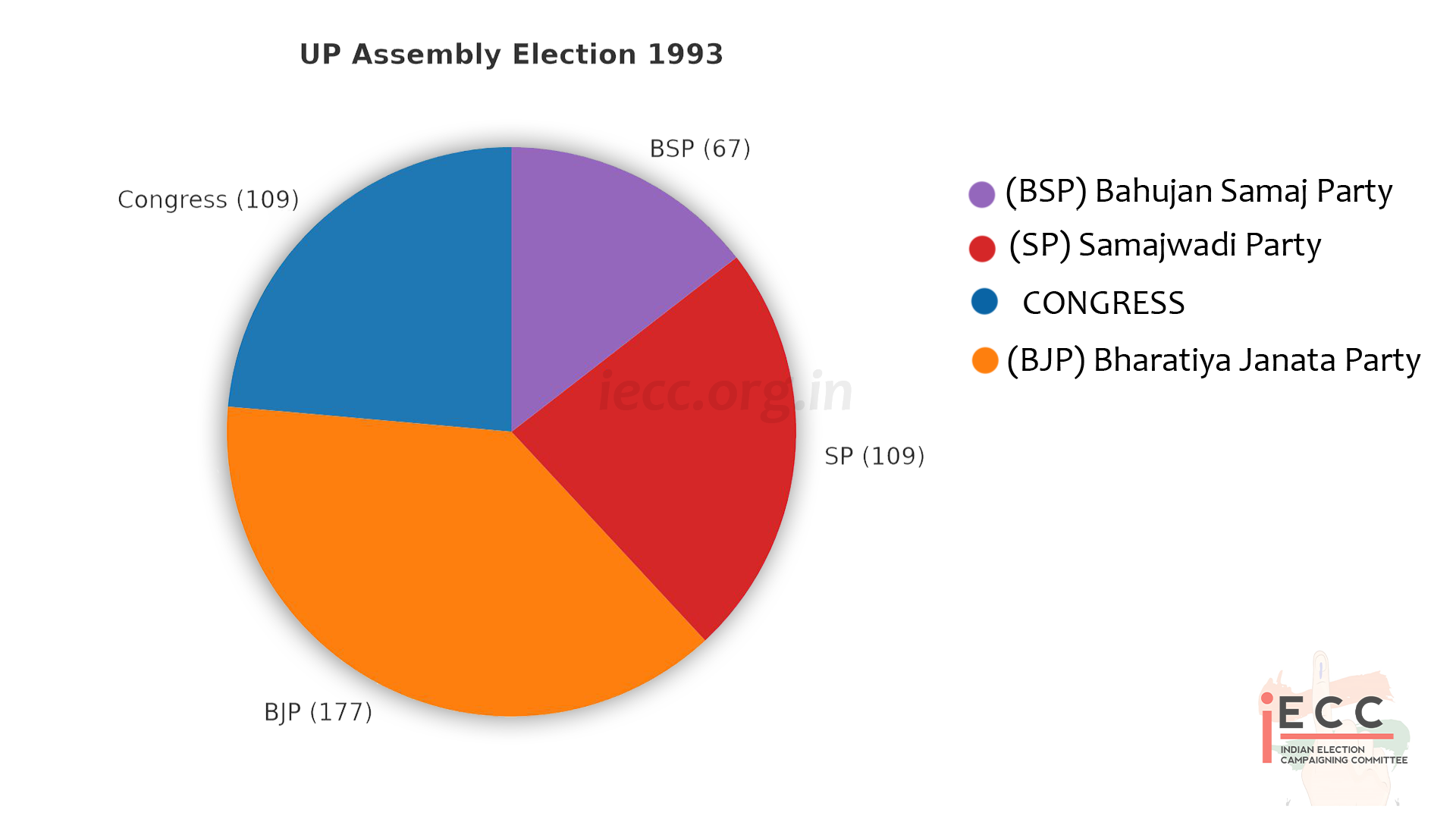
1996 Uttar Pradesh Legislative Assembly Election Results
| 1996 Uttar Pradesh Legislative Assembly Election Results | |||
|---|---|---|---|
| Sr. No. | Short Name | Full Name | Seats |
| 1 | BJP | Bharatiya Janata Party | 174 |
| 2 | SP | Samajwadi Party | 110 |
| 3 | BSP | Bahujan Samaj Party | 67 |
| 4 | INC | Indian National Congress | 33 |
| 5 | Janata Dal | Janata Dal | 12 |
| 6 | CPI | Communist Party of India | 2 |
| 7 | Marxist) (CPI-M | Communist Party of India | 1 |
| 8 | Independents & Others | Independents & Others | 26 |
| Total | 425 | ||
The 1996 election produced a hung assembly with no single party close to the majority mark (213).
The BJP emerged as the largest party with 174 seats, but it was short of a majority.
The Samajwadi Party (SP) secured 110 seats, while the Bahujan Samaj Party (BSP) again won 67 seats, holding the balance of power.
Congress continued its decline, winning only 33 seats.
The fractured mandate led to political instability:
Initially, President’s Rule was imposed.
Later, a coalition arrangement between BJP and BSP was tried with Mayawati becoming CM for short periods, alternating power with BJP leaders.
This period marked the rise of coalition politics and frequent changes of government in Uttar Pradesh.
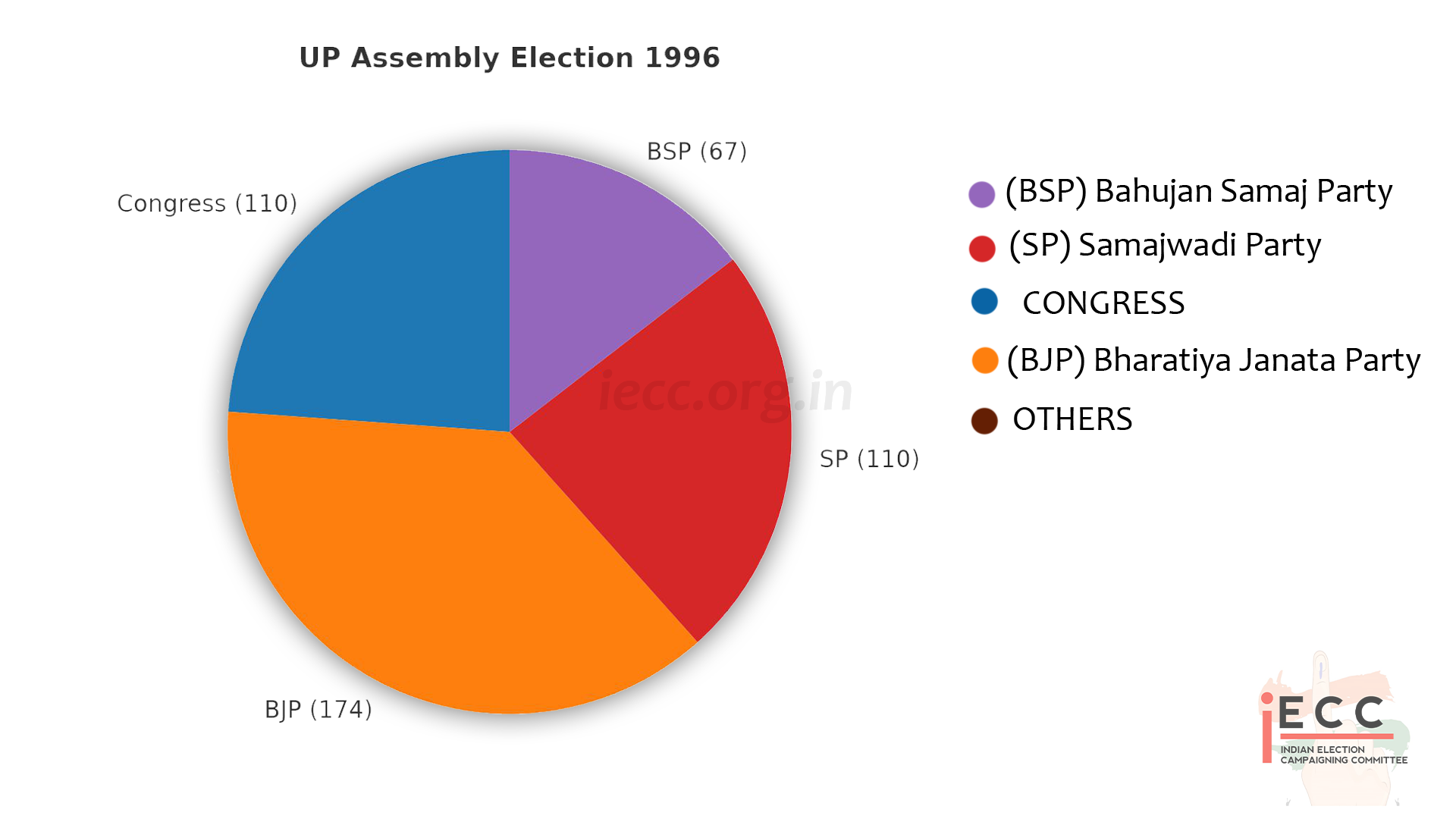
2002 Uttar Pradesh Legislative Assembly Election Results
| 2002 Uttar Pradesh Legislative Assembly Election Results | |||
|---|---|---|---|
| Sr. No. | Short Name | Full Name | Seats |
| 1 | SP | Samajwadi Party | 143 |
| 2 | BSP | Bahujan Samaj Party | 98 |
| 3 | BJP | Bharatiya Janata Party | 88 |
| 4 | INC | Indian National Congress | 25 |
| 5 | RLD | Rashtriya Lok Dal | 14 |
| 6 | CPI | Communist Party of India | 4 |
| 7 | (Marxist) (CPI-M) | Communist Party of India | 2 |
| 8 | Independents & Others | Independents & Others | 29 |
| Total | 403 | ||
The 2002 election gave a fractured verdict, with no party anywhere near the majority mark (202).
The Samajwadi Party (SP), led by Mulayam Singh Yadav, emerged as the largest party with 143 seats.
The Bahujan Samaj Party (BSP), led by Mayawati, came second with 98 seats, while the BJP fell to 88 seats, continuing its decline after 1991–1996 dominance.
The Congress (INC) was reduced to 25 seats, signaling its marginalization in UP politics.
After long negotiations, Mayawati (BSP) formed the government with outside support from BJP in May 2002.
However, the alliance collapsed within months, and later in 2003, Mulayam Singh Yadav (SP) became Chief Minister with support from defectors.
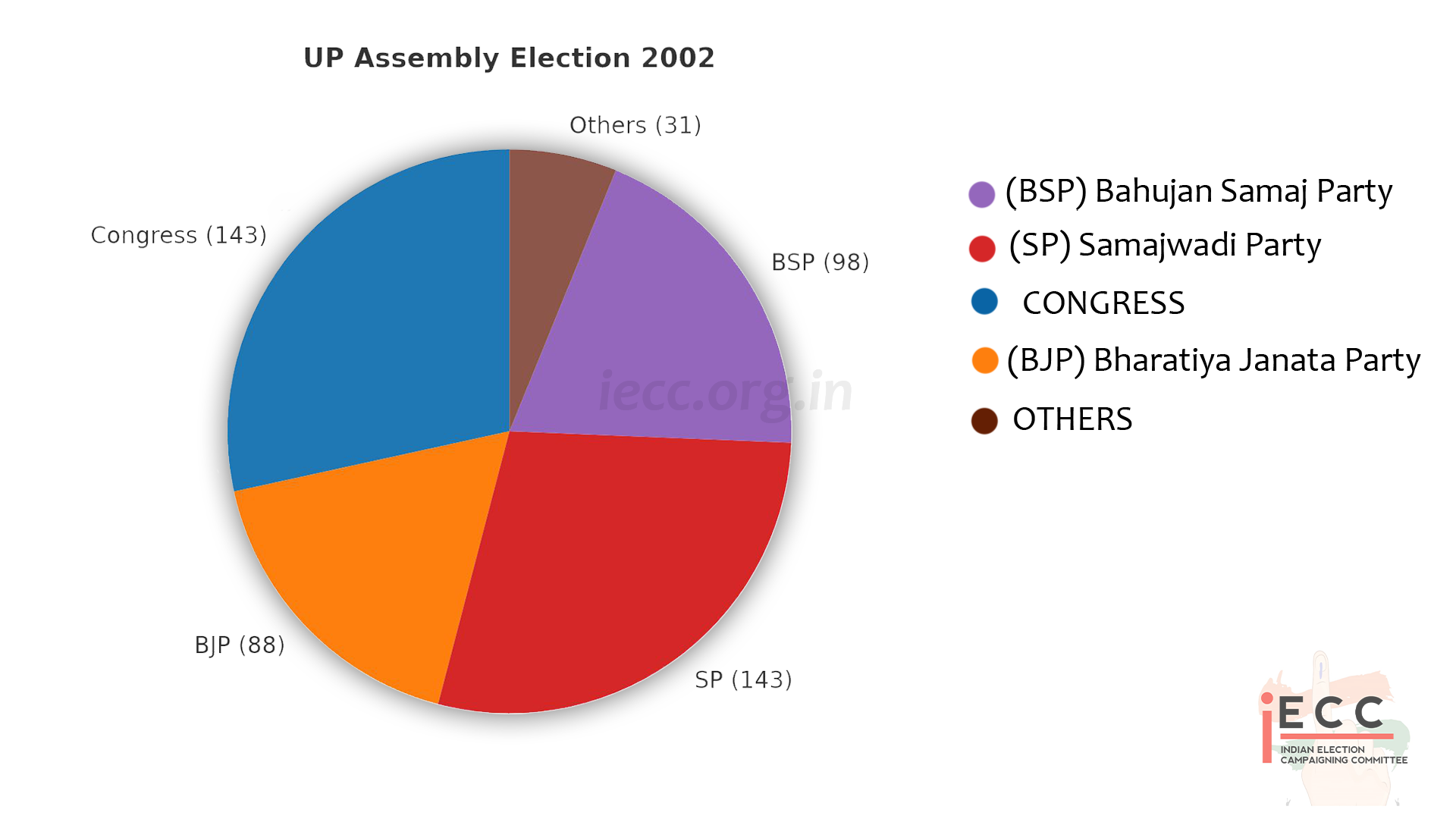
2007 Uttar Pradesh Legislative Assembly Election Results
| 2007 Uttar Pradesh Legislative Assembly Election Results | |||
|---|---|---|---|
| Sr. No. | Short Name | Full Name | Seats |
| 1 | BSP | Bahujan Samaj Party | 206 |
| 2 | SP | Samajwadi Party | 97 |
| 3 | BJP | Bharatiya Janata Party | 51 |
| 4 | INC | Indian National Congress | 22 |
| 5 | RLD | Rashtriya Lok Dal | 10 |
| 6 | Independents & Others | Independents & Others | 17 |
| Total | 403 | ||
The 2007 election was a landmark victory for Mayawati’s Bahujan Samaj Party (BSP), which secured 206 seats — a clear majority on its own.
This was the first time BSP formed a government independently without coalition partners.
Mayawati’s success came from her strategy of “social engineering”, combining Dalit support base with Brahmin, Muslim, and OBC communities.
The Samajwadi Party (SP) was pushed to second place with 97 seats, losing ground after Mulayam Singh Yadav’s government.
The BJP continued its decline, managing only 51 seats, while the Congress further weakened with just 22 seats.
Chief Minister after election: Mayawati (BSP) returned as CM, beginning her fourth term and completing a full 5-year tenure (2007–2012) — rare in UP politics.
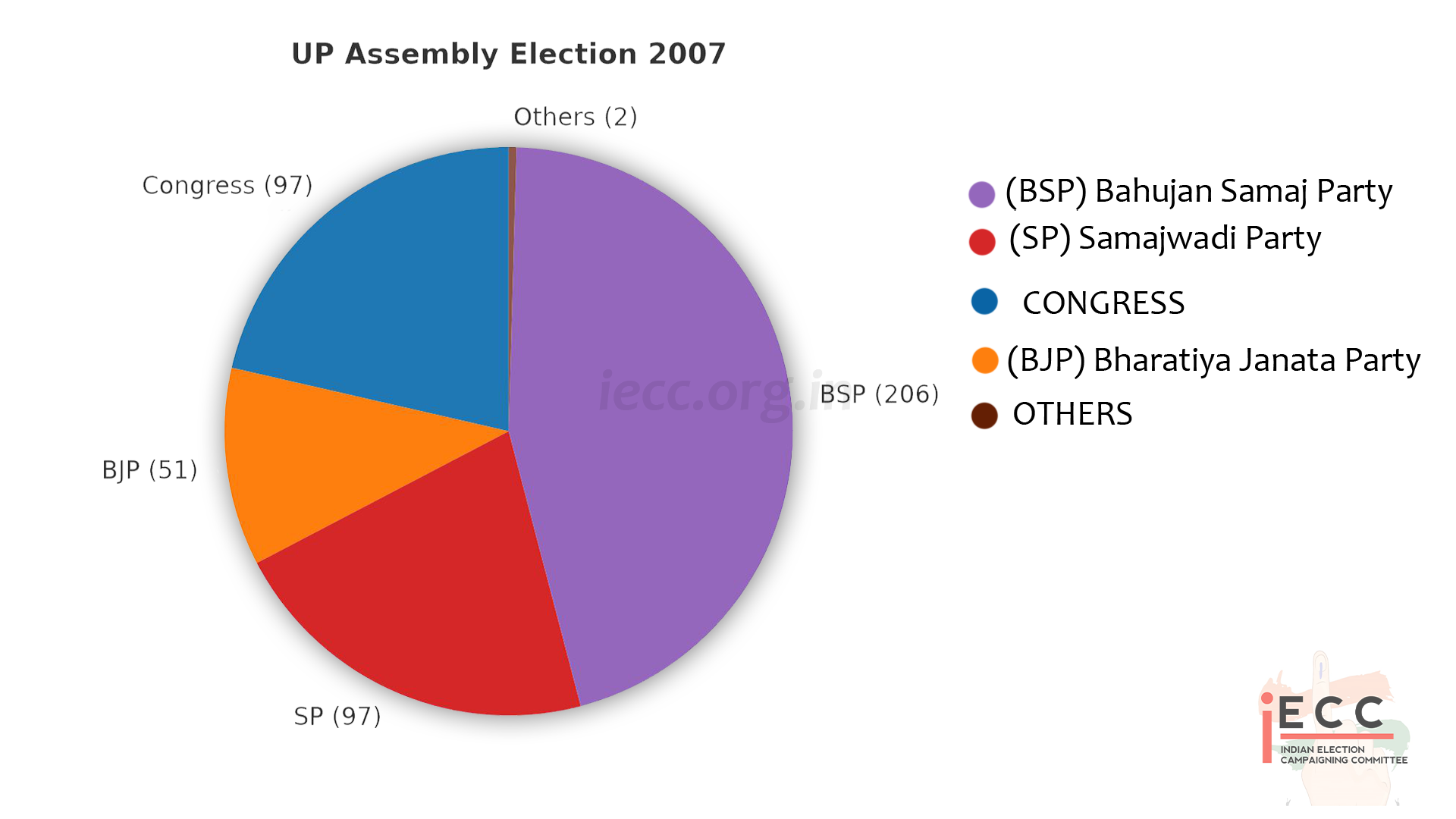
2012 Uttar Pradesh Legislative Assembly Election Results
| 2012 Uttar Pradesh Legislative Assembly Election Results | |||
|---|---|---|---|
| Sr. No. | Short Name | Full Name | Seats |
| 1 | SP | Samajwadi Party | 224 |
| 2 | BSP | Bahujan Samaj Party | 80 |
| 3 | BJP | Bharatiya Janata Party | 47 |
| 4 | INC | Indian National Congress | 28 |
| 5 | RLD | Rashtriya Lok Dal | 9 |
| 6 | Independents & Others | Independents & Others | 15 |
| Total | 403 | ||
The 2012 election delivered a clear majority to the Samajwadi Party (SP), which won 224 seats, crossing the majority mark (202).
The result marked a youth wave as Akhilesh Yadav, son of Mulayam Singh Yadav, led the campaign and became the youngest Chief Minister of UP at age 38.
The BSP, which had ruled under Mayawati from 2007–2012, suffered a huge defeat, falling to 80 seats.
The BJP continued to struggle in the state, winning only 47 seats, though it was preparing for a bigger comeback later.
The Congress (INC), despite aggressive campaigning by Rahul Gandhi, secured only 28 seats, showing limited revival.
This election marked the shift of power back to SP with a new leadership face in Akhilesh Yadav.
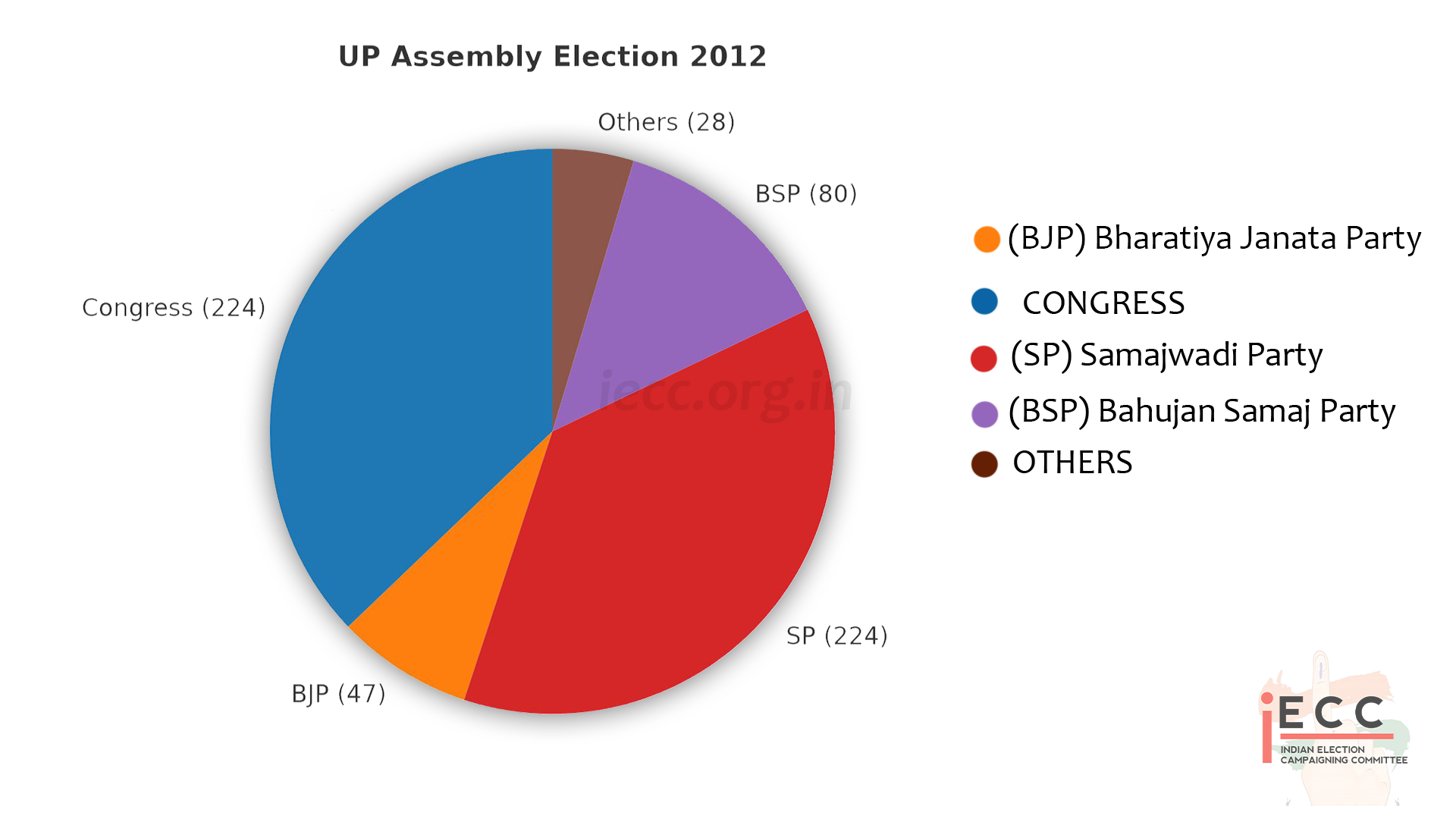
2017 Uttar Pradesh Legislative Assembly Election Results
| 2017 Uttar Pradesh Legislative Assembly Election Results | |||
|---|---|---|---|
| Sr. No. | Short Name | Full Name | Seats |
| 1 | BJP | Bharatiya Janata Party | 312 |
| 2 | SP | Samajwadi Party | 47 |
| 3 | BSP | Bahujan Samaj Party | 19 |
| 4 | INC | Indian National Congress | 7 |
| 5 | (Sonelal) [ally of BJP | Apna Dal | 9 |
| 6 | (SBSP) [ally of BJP] | Suheldev Bharatiya Samaj Party | 4 |
| 7 | Independents & Others | Independents & Others | 5 |
| Total | 403 | ||
The 2017 election was a landslide victory for the Bharatiya Janata Party (BJP), which won 312 seats on its own and crossed 325 seats with allies.
This was the biggest majority in Uttar Pradesh since 1977, completely reshaping state politics.
The Samajwadi Party (SP), led by Akhilesh Yadav, collapsed to 47 seats, despite an alliance with Congress.
The Bahujan Samaj Party (BSP) was reduced to just 19 seats, its worst-ever performance.
The Congress (INC), despite heavy campaigning by Rahul Gandhi, managed only 7 seats.
The BJP’s success was powered by:
Narendra Modi’s popularity and central leadership.
Strong Hindutva wave and caste re-alignments.
Weak opposition unity.
Chief Minister after election: In a surprise move, the BJP appointed Yogi Adityanath as CM, who became the first BJP leader to serve a full term in UP.

2022 Uttar Pradesh Legislative Assembly Election Results
| 2022 Uttar Pradesh Legislative Assembly Election Results | |||
|---|---|---|---|
| Sr. No. | Short Name | Full Name | Seats |
| 1 | BJP | Bharatiya Janata Party | 255 |
| 2 | Apna Dal | Apna Dal | 12 |
| 3 | [BJP ally] | Nishad Party | 6 |
| 4 | SP | Samajwadi Party | 111 |
| 5 | (RLD) [SP ally] | Rashtriya Lok Dal | 8 |
| 6 | (SBSP) [SP ally] | Suheldev Bharatiya Samaj Party | 6 |
| 7 | INC | Indian National Congress | 2 |
| 8 | (BSP) | Bahujan Samaj Party | 1 |
| 9 | Independents & Others | Independents & Others | 2 |
| Total | 403 | ||
The 2022 election marked a historic win for the BJP, as it became the first party in 37 years to retain power in Uttar Pradesh for two consecutive terms.
The BJP won 255 seats on its own, and along with allies (Apna Dal(S) and Nishad Party), the NDA secured 273 seats — a comfortable majority.
The Samajwadi Party (SP) under Akhilesh Yadav performed strongly, winning 111 seats (its best tally since 2012), but still far from forming government.
The RLD and SBSP, allies of SP, contributed small numbers, taking the SP+ alliance total to 125 seats.
The Bahujan Samaj Party (BSP) collapsed dramatically, winning just 1 seat, while the Congress (INC) fared even worse with 2 seats.
Chief Minister after election: Yogi Adityanath (BJP) returned as CM, becoming the first UP CM in 37 years to win re-election and complete a term.
